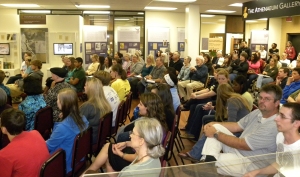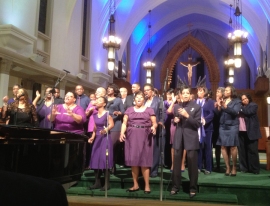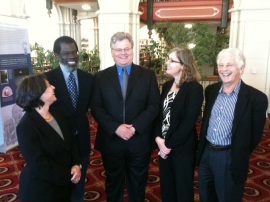A Grand Tour Draws to a Close

A large crowd gathered to hear four Kennesaw State University faculty discuss the history and language of the King James Bible in Kennesaw, GA.
It feels like yesterday that I was drafting the itinerary for the Manifold Greatness traveling exhibition to libraries. Almost two years later, the exhibition has traveled to 40 libraries across the United States, and it wraps up at its final site—Nancy Guinn Memorial Library of the Conyers-Rockdale Library System in Conyers, Georgia—on July 12, 2013. The ALA Public Programs Office has been honored to coordinate the tour to public and academic libraries, who presented a variety of free humanities programs in conjunction with the exhibition.
Host libraries enthusiastically planned for Manifold Greatness. Library patrons were exposed to more than 230 programs related to the King James Bible—and more than 130,000 people visited the exhibition over the course of the project! To illustrate the creative hard work of library hosts, here is a sampling of just a few of the many unique programs presented:
-

The Sacred Praise Chorale chorale at Loyola Marymount University in California. Photo by Jeannine Emmett.
Lecture: “The King’s English in a Tamil Tongue” was presented by Dr. Dyron Daughrity—Pepperdine University Library, Malibu, CA
- Lecture: “King James Bible and Two of Its Famous Contemporaries: William Shakespeare and John Milton” was presented by Drs. Edward Jones and David Anderson, followed by discussion—Oklahoma State University Library, Stillwater, OK
- Lecture: “The Role the KJB Played in Mormonism and the Settlement of the West” was presented by Dr. Philip L. Barlow, Arrington Chair of Mormon History and Culture, Utah State University—University of Wyoming Libraries, Laramie, WY
- Activity: “Illuminations Family Night,” a family activity in which the Utah Calligraphy Artists taught children about illuminating manuscripts—Provo Library, Provo, UT
- Musical performance: “Praise Ye The Lord: A Festival of Hymns Inspired by the King James Bible,” music performance, script, and sing-a-long of hymns—Transylvania County Library, Brevard, NC
-

At Rhodes College in Memphis: Naomi Tadmor, Vincent Wimbush, Hannibal Hamlin, Ena Heller, Robert Alter
Demonstration: “Teen 19th Century Bloggers”; Tracy Honn of Silver Buckle Press demonstrated the use of a nineteenth century printing press for ages 11 to 18—Verona Public Library, Verona, WI
- Lecture: “Covering the Feet: Scatological References in the King James Bible” was presented by Dr. Daniel C. Browning, Jr. who discussed the King James Bible from an archaeologist’s point of view—William Carey University, Hattiesburg, MS
- Presentation: “Impact of Scripture on Dr. Martin Luther King, Jr.,” a lecture given by Reverend O’Neil Wiley, was accompanied by dramatic readings from two of Dr. King’s speeches by University of Mobile theater major Broderick S. Ryans—Ben May Main Library of the Mobile Public Library, Mobile, AL
- Lecture: “The First Editions of the King James Bible: Misprints and Misfortunes” was presented by Dr. Pablo Alvarez, who talked about the printing process that led to errors in the first editions of the King James Bible—Van Wylen Library, Hope College, Holland, MI
- Presentation: “The Family Bible: A Historical and Genealogical Resource” offered owners of family bibles information on how to use their treasured family heirlooms as a tool when doing genealogical and historical research—Kennesaw State University, Kennesaw, GA
- Lecture: “Catholics and the King James Bible: Stories from England, Ireland, and America” was presented by Dr. Ellie Bagley from Middlebury College—Rhodes College, Memphis, TN
In addition to stellar program line-ups, libraries reported that the exhibit provided them with the opportunity to try new programming formats.
Project Director Katy Kelly at the University of Dayton opened up exhibit-related brown bag lunches—typically limited to faculty and staff—to the public. Kelly said the new lunchtime presentations were very well-attended and “brought greater awareness to the local community of the kinds of scholarship and research our faculty undertake.”
Project director Steve Silver of Northwest Christian University commented on the long-term impact of hosting the exhibit. He said, “Connections made with local groups as a result of Manifold Greatness endure after a year and a half since we hosted the exhibit. Those connections would not have been made without the requirements of the grant.”
Even though the exhibition’s grand tour is coming to an end, ALA looks forward to building on the inspiring success of Manifold Greatness in our future work with libraries.
Jennifer Dominiak is a program officer for exhibitions in the Public Programs Office at the American Library Association.
Translating Manifold Greatness from Scholarship to Exhibition

Miles Smith, one of the King James Bible translators. (c) The Governing Body of Christ Church, Oxford.
Back in 2009, when we first started working on Manifold Greatness, we identified a number of themes we wanted the exhibition to touch on, and one of those was the nature of translation. In our grant proposal, we talk about how translation is a true literary act, one that requires choices in tone, style, vocabulary, and emphasis, and how translation is a process of culture adapting, changing, and potentially growing. On our main website, we note that the translation of the KJB was, above all, a collaboration.
The Manifold Greatness traveling panel show is now on the way to its final location, the Conyers-Rockdale Library System in Conyers, Georgia, where it will appear, with much related programming, from May 29 to July 12. And as this touring phase comes to a close, I’ve been looking back at our own process, and thinking about the way in which exhibitions themselves are a process of translation. Of course we collaborate—anyone who has worked on an exhibition can tell you that it is one of the most collaborative undertakings they have experienced. But because we tend to think of translation as a text moving from one language into another, it’s not immediately obvious that the work we do in exhibition is also a process of translation. And yet, on many levels, I think it is.
We begin with an idea, and shape it into a narrative: here is our story; here is what can be said about the history of the King James Bible. But as scholars, our curators have a certain language, a way of packaging their knowledge. This does not always (ahem) translate well to an audience which may be made up of everyone from schoolchildren and educators to tourists or subject specialists. We need a way of speaking, and of writing, that provides information accurately and succinctly, and in accessible nuggets for a broad range of audiences.
For Manifold Greatness, we did this twice: once for the artifact-based exhibition in Washington, DC, and again for the panel exhibition that traveled the country. For these, we needed two different “languages.” The Washington, DC, show was in the language of artifacts, showing the here and now, and revealing KJB stories through what could be seen on the open pages before a visitor. The traveling show retracted the lens a little further, and gave weight to story over object. We covered the same material, but we translated the content in slightly different ways in order to best serve the format of the shows.
I like to think that the KJB translators would have appreciated our process. Our translation process was, like theirs, concerned first and foremost with accuracy. Every word needed to be true; each idea needed to be formed and informative. We were not reading Hebrew, Greek, and Latin—but remember, of course, that the King James Bible was not the first English Bible, and the translators drew liberally from the English translations that came before. Although they produced a masterpiece of English literature, their concern was not for lyricism or rhetorical power; they aimed for accuracy as they translated both from ancient languages and from previous English versions.
Have a look at the website to compare translations, and see for yourself how the KJB translators ended up creating a new version at once lyrical and accurate. One of my favorites is the passage from Ecclesiastes (1:2), in which the translators don’t really change the meaning or emphasis from the previous English translation, but they manage to create a verse that is poetic, song-like, and memorable—and also just that much more true to the original Hebrew:
Great Bible (1539)
All is but vanity (saith the Preacher) all is but plain vanity.
King James Bible (1611)
Vanity of vanities, saith the Preacher, vanity of vanities; all is vanity.
Would that our exhibit text was as memorable as that! Perhaps it is indeed vanity to compare our process to that of the King James Bible translators. But as we near the end of this commemorative exhibition, I’m very pleased to have been part of such a process, to understand it, and to see the many thousands of people we have reached through the work that we did to turn ideas into language, and to use language to deliver the right information.
Caryn Lazzuri is the Exhibitions Manager at the Folger Shakespeare Library.
Touchstone Moments for the Folger Exhibition
You might think that exhibitions at the Folger Shakespeare Library are all about books and manuscripts and art—and you’d be right. But precisely because these types of paper-based artifacts can be challenging to display in new and engaging ways, I encourage curators to look for other types of objects to reflect the content and themes of each exhibition. For Manifold Greatness, we were presented with a rich and interesting topic, but one that was explicitly about a single book. One of the goals was to make this 400-year-old book come alive with human stories about its creation and its afterlife, so curators Steve Galbraith and Hannibal Hamlin began brainstorming with me about how to do that with a series of “touchstone moments” around the Great Hall.
Hannibal wanted a scene all about the sounds of the King James Bible, and for this, we borrowed a pew and lectern from the Lutheran Church of the Reformation. With a nineteenth-century Bible on the lectern, and a listening station with an interactive feature from the website, exhibition-goers can hear short, familiar passages read aloud by actors, as well as commentary from Hannibal and Steve.
Across the hall is a family Bible scene that brings to mind nineteenth-century households where the King James Bible was a fixture in the lives of many American and English families. Here, a nineteenth-century Bible sits open on a table, with candlesticks for light, and a pair of reading glasses. Touring the exhibition recently, a colleague said to me, “The spectacles really make this one come alive.”
A mid-twentieth-century parlor radio (photo, above) and a postcard from the Moody Bible Institute comprise a third touchstone. The Moody Bible Institute in Chicago, which began broadcasting Moody Radio in the 1920s, remains one of the largest Christian radio stations in the country. Its greatest popularity was in the 1950s and 60s, and we included it as an example of the more contemporary influences of the King James Bible in American culture.
Perhaps the most challenging touchstone in Manifold Greatness is the very first one. Our case on martyrs and heretics explores early English Bible translators like John Wyclif, William Tyndale, Miles Coverdale, and John Rogers. A wall panel displays woodcuts from John Foxe’s Actes and Monuments that depict the grisly fates some of these translators met. Tyndale and Rogers were both burned at the stake, and Wyclif’s bones were exhumed and burned in the late fifteenth century.
When Steve Galbraith walked into my office and suggested it would really make a statement to have our own stake at this point in the exhibition, I wasn’t sure what to think—or how we’d manage it. But with a small tree, a few bundles of twigs, a friend at the Smithsonian who gave us access to a large freezer (to make sure nothing was alive in that small tree or those bundles of twigs), a handy technical director in the Folger Theatre, and some creative camouflage painting by our Folger conservators, we built a modest stake right there in the Great Hall.
While we don’t intend to burn anyone at our touchstone stake, we hope these vignettes make the exhibition come alive for visitors, and draw them into its unique world. Come see for yourself!
The Manifold Greatness exhibition is open through January 16 at the Folger Shakespeare Library in Washington, DC. Admission is free. See our Tips for Visitors blog post for more information.
Caryn Lazzuri is exhibitions manager at the Folger Shakespeare Library and has previously written about previewing the traveling exhibit at the ALA annual meeting in New Orleans and installing the Folger Manifold Greatness exhibition.










